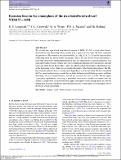Files in this item
Emission lines in the atmosphere of the irradiated brown dwarf WD0137−349B
Item metadata
| dc.contributor.author | Longstaff, E. S. | |
| dc.contributor.author | Casewell, S. L. | |
| dc.contributor.author | Wynn, G. A. | |
| dc.contributor.author | Maxted, P. F. L. | |
| dc.contributor.author | Helling, Ch. | |
| dc.date.accessioned | 2017-09-27T09:30:10Z | |
| dc.date.available | 2017-09-27T09:30:10Z | |
| dc.date.issued | 2017-10-21 | |
| dc.identifier | 251179933 | |
| dc.identifier | d1831742-b2da-4ff5-b9d0-8a922f2448a7 | |
| dc.identifier | 85044167177 | |
| dc.identifier | 000409022700028 | |
| dc.identifier.citation | Longstaff , E S , Casewell , S L , Wynn , G A , Maxted , P F L & Helling , C 2017 , ' Emission lines in the atmosphere of the irradiated brown dwarf WD0137−349B ' , Monthly Notices of the Royal Astronomical Society , vol. 471 , no. 2 , pp. 1728-1736 . https://doi.org/10.1093/mnras/stx1786 | en |
| dc.identifier.issn | 0035-8711 | |
| dc.identifier.other | RIS: urn:AF008127FF4D23DF5B2E7FFDE498E6EE | |
| dc.identifier.uri | https://hdl.handle.net/10023/11749 | |
| dc.description | ESL acknowledges the support of STFC studentship. SLC acknowledges support from the University of Leicester College of Science and Engineering. CH highlights the financial support of the European community under the FP7 ERC starting grant 257431. This work was supported by the Science and Technology Facilities Council [ST/M001040/1]. | en |
| dc.description.abstract | We present new optical and near-infrared spectra of WD0137−349; a close white dwarf–brown dwarf non-interacting binary system with a period of ≈114 min. We have confirmed the presence of H α emission and discovered He, Na, Mg, Si, K, Ca, Ti and Fe emission lines originating from the brown-dwarf atmosphere. This is the first brown-dwarf atmosphere to have been observed to exhibit metal emission lines as a direct result of intense irradiation. The equivalent widths of many of these lines show a significant difference between the day-side and night-side of the brown dwarf. This is likely an indication that efficient heat redistribution may not be happening on this object, in agreement with models of hot Jupiter atmospheres. The H α line strength variation shows a strong phase dependency as does the width. We have simulated the Ca ii emission lines using a model that includes the brown-dwarf Roche geometry and limb darkening, and we estimate the mass ratio of the system to be 0.135 ± 0.004. We also apply a gas-phase equilibrium code using a prescribed drift-phoenix model to examine how the chemical composition of the brown-dwarf upper atmosphere would change given an outward temperature increase, and discuss the possibility that this would induce a chromosphere above the brown-dwarf atmosphere. | |
| dc.format.extent | 9 | |
| dc.format.extent | 1250682 | |
| dc.language.iso | eng | |
| dc.relation.ispartof | Monthly Notices of the Royal Astronomical Society | en |
| dc.subject | Binaries: close | en |
| dc.subject | Brown dwarfs | en |
| dc.subject | White dwarfs | en |
| dc.subject | QB Astronomy | en |
| dc.subject | QC Physics | en |
| dc.subject | NDAS | en |
| dc.subject.lcc | QB | en |
| dc.subject.lcc | QC | en |
| dc.title | Emission lines in the atmosphere of the irradiated brown dwarf WD0137−349B | en |
| dc.type | Journal article | en |
| dc.contributor.sponsor | European Research Council | en |
| dc.contributor.institution | University of St Andrews. School of Physics and Astronomy | en |
| dc.contributor.institution | University of St Andrews. St Andrews Centre for Exoplanet Science | en |
| dc.identifier.doi | 10.1093/mnras/stx1786 | |
| dc.description.status | Peer reviewed | en |
| dc.identifier.grantnumber | 257431 257431 | en |
This item appears in the following Collection(s)
Items in the St Andrews Research Repository are protected by copyright, with all rights reserved, unless otherwise indicated.

